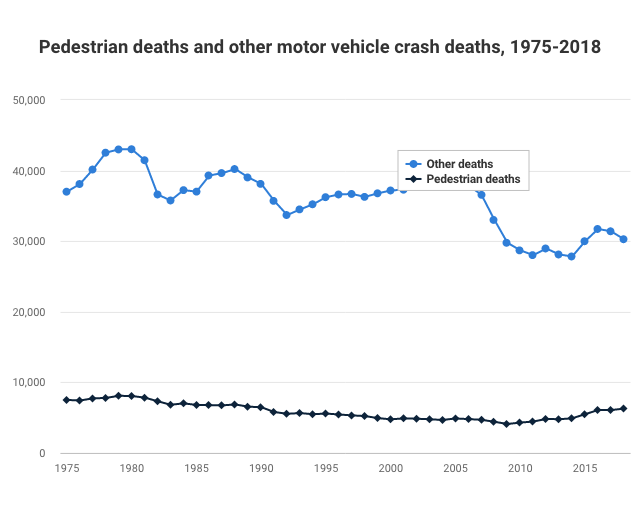Traffic safety may be subjective, but designing the road shouldn’t be

Silver Spring protected bikways, and floating bus stop by BeyondDC licensed under Creative Commons.
A fundamental tenet of Vision Zero is the explicit acknowledgment that the transportation network needs to be designed for the safety of everyone - people driving, people using transit, people walking, and people bicycling or using scooters, etc. However, most (but not all) transportation infrastructure has been built to facilitate automobiles and roadway design that implicitly supports motor vehicle primacy and safety.
This is most apparent in design standards that require wide “clear zones” next to roadways for vehicles that may veer off-road, or traffic signs and utility poles that are built to “breakaway” if a motorist crashes into them. These features are required to help prevent a motorist from injuring themself in the event of a crash. However, using flex-posts instead of metal bollards to separate a bicycle lane, or prohibiting a barrier from separating a sidewalk does not prevent the serious injury of a person walking or bicycling in the event of a crash with a person driving a vehicle.
Last year, the State of Maryland and Prince George’s County joined Montgomery County and adopted Vision Zero. As these jurisdictions develop strategic plans to comprehensively implement Vision Zero, roadway agencies will need to re-evaluate their engineering standards and develop designs that better prevent injury for everyone that may be using the roadway. But what does safety for everyone look like?
Safety can be subjective
People driving, walking, taking transit, bicycling, or using other modes have differing opinions of what makes a roadway safe. Similarly, elected officials, civil engineers, emergency responders, transportation planners, and the public all use the transportation network in their own way, which impacts how safety is perceived.
For instance, a person driving an automobile may consider an arterial roadway with a speed limit of 40 mph, a bicycle lane, and a sidewalk to be safe. However, the person bicycling may consider the road to be unsafe, and if the sidewalk is immediately against the curb with no buffer, a person walking may have a similar perception.
It’s valuable to look at safety through two lenses.
- Is the transportation environment safe for the person traveling, regardless of mode? (i.e. I am safe traveling through here?)
- Is the transportation environment safe for everyone else in all other modes? (i.e. Is everyone else safe traveling through here?)
Safety features of motor vehicles have improved dramatically over the years, and the size of motor vehicles has generally increased, which has led to increased safety for the person inside the vehicle. However, this does not make it safer for people outside motor vehicles. National crash data reflect this trend - while total crash-related fatalities have reduced over time, pedestrian fatalities have risen.
Overall, traffic fatalities are reducing, but the proportion of pedestrian fatalities is increasing. from IIHS and HLDI. Pedestrian and Motor Vehicle Deaths 1975-2018 by Insurance Institute for Highway Safety and the Highway Loss Data Institute.
As an example, a person in a large SUV would likely be safe in a collision, but they would have a disproportionately large impact on another person. If a motorist crashed into a bus stop where people were waiting:
- The transportation environment is safe for the person traveling in the SUV, but
- The transportation environment is not safe for everyone else.
A person driving a car may feel safe next to a person walking, but a person walking doesn't necessarily feel safe next to a car. All distances are relative. Image by the author.
While it is not possible (nor desirable) to choose how everyone travels, it is possible to design a transportation system that increases everyone’s safety. “Engineering” is included as one of the key “Es” to achieving the goals of Vision Zero. This means roadways are designed first for safety.
Last fall, Montgomery County, Maryland built a protected intersection at 2nd Avenue and Spring Street.
The protected intersection at 2nd Avenue and Spring Street. Image by Montgomery County Department of Transportation Division of Transportation Engineering.
This intersection has corner islands, advanced stop lines, separated bicycle lanes, and set back crossings, all of which help separate different modes of travel and help make all road users more visible to each other.
The way ahead
Not all intersections in the region will have the kinds of improvements that have been added to 2nd Avenue and Spring Street, but the intersection provides an illustrative example of how transportation planners and civil engineers need to approach roadway design. Vision Zero requires that each person’s subjective perception of safety is taken into account and then the roadway is objectively designed for the safety of all people in all modes.
